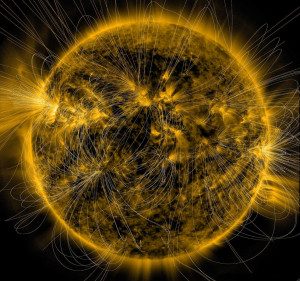
15 March 2016 – Having semi-retired last week, I find most of my days filled with fun things. And one of them is spending more time with my second love (my wife being my first love) and that’s science – all of it. And especially toying around on NASA’s main web site and all of its corollary/linked sites.
This illustration above lays a depiction of the sun’s magnetic fields over an image captured by NASA’s Solar Dynamics Observatory on March 12, 2016. The complex overlay of lines can teach scientists about the ways the sun’s magnetism changes in response to the constant movement on and inside the sun. Note how the magnetic fields are densest near the bright spots visible on the sun – which are magnetically strong active regions – and many of the field lines link one active region to another.
This magnetic map was created using the PFSS – Potential Field Source Surface – model, a model of the magnetic field in the sun’s atmosphere based on magnetic measurements of the solar surface. The underlying image was taken in extreme ultraviolet wavelengths of 171 angstroms. This type of light is invisible to our eyes, but is colorized here in gold.
Magnetic fields are amazing things. Five years ago when I made my first visit to CERN to see the Large Hadron Collider (LHC) I learned that it was possible that when the LHC was “fully turned up” it could wiped out Earth’s magnetic field — which it subsequently did, albeit temporarily.
Note: soon after the crack-pot theories started. The LHC could generate a magnetic field that could somehow pull an iron-laden space rock off course towards Earth with catastrophic consequences. And the LHC could even open up a portal from another dimension through which an unexpected comet or asteroid could suddenly appear before hitting Earth out of the blue. Oh, and my favorite: the LHC could summon the Anti-Christ to earth to cause an apocalypse.
Grasping what drives the sun’s magnetic system is crucial for understanding the nature of space throughout the solar system: the sun’s invisible magnetic field is responsible for everything from the solar explosions that cause space weather on Earth – such as auroras – to the interplanetary magnetic field and radiation through which our spacecraft journeying around the solar system must travel.
Here is a great video that puts it in perspective: